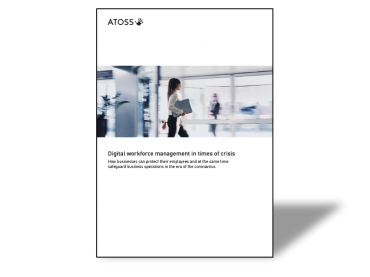The impact of the crisis on the logistics sector
Trust takes years to build and seconds to break, also in modern supply chains
Learn more about Workforce Management in the logistics sector
Short of staff? I wish you many – flexible – employees
Short of demand? Massive lay-offs of flexible workers despite wage support scheme
Temporarily less work? Think creatively and optimize processes
Optimizing workforce management processes: how do you get started?
Workforce Management in times of crisis: Download our Factsheet
Six months ago, if anyone had told me I would now be making most of my calls from my kitchen table, I’d have called them crazy. However, due to the coronavirus, it has become the new reality and I’ve had to get used to it. As a young professional, I live with two housemates whom are now also working from home. Quite a change from getting through the working week separately and then kicking off the weekend together with a well-earned beer... We’ve all had to learn how to work from home in our own way. Now, I’m talking with companies in the logistics world again “as before the crisis”.
These conversations are making me more aware of how unique the current situation is. Various world leaders are calling the crisis “the greatest challenge ever faced in peacetime”. But to be honest, I don’t really notice it that much. Of course, I’m working from home, I have to walk down the street unaccompanied, do my groceries on my own, observe social distancing, and I keep washing my hands, et cetera. Only when I’m talking to companies in the logistics sector, the current crisis really gets noticeable. The effects and contrasts become immediately visible and magnified. In this blog, I will relate what I find the most striking.
Trust takes years to build and seconds to break, also in modern supply chains
The international transport sector is suffering because every country has different laws and regulations on how to deal with the coronavirus crisis. In Europe, each country is taking its own measures. For firms with cross-border operations, this is increasing paperwork and slowing down processes along the entire distribution chain. Since the emergence of the coronavirus, the consumers’ trust in the supply chain has tumbled into uncertainty. After some hilarity about buying vast quantities of toilet paper and groceries, they had to endure a great deal of criticism. But was that justified?
Hoarding is actually stockpiling of a safety stock of goods for emergencies. Consumers find it difficult to estimate how many products they need, especially in uncertain times. Forming a sound estimate of their emergency stocks is even harder for firms with complex supply chains. If one link in the chain buys less stock than expected, the effect reverberates all the way up the line, amplifying a little further at each point. Actual demand fluctuates strongly as a result. This bullwhip effect can be overcome by a good forecast that allows emergency stocks to be estimated more accurately. But in an unpredictable crisis, this is extremely difficult to achieve.
Consequently, it’s also harder to determine staffing needs and to scale quickly up and down. Here, too, optimized forecasting is crucial, as are capacity planning and a flexibly deployable workforce. An advanced digital workforce management solution makes all of this transparent and feasible.

You want to learn more about Workforce Management in the logistics sector? CLICK HERE.
Short of staff? I wish you many – flexible – employees
The economy may have ground to a halt for many entrepreneurs, but some types of logistic businesses are barely coping with the explosive demand surge. E-commerce and parcel services, for instance, are booming. Big online retailers can’t find enough staff for their warehouses. DHL recorded its busiest day in history, while PostNL, a large Dutch postal and parcel company, has been warning about delays for weeks. However, opening up extra staffing resources isn’t going to happen in an industry with a structural personnel shortage and specific knowledge requirements. As a result, understaffing has to be resolved by, for instance, improving process efficiency and getting existing personnel to step in. To take a few examples:
- Housewares retailer HEMA is currently converting 20 stores into e-commerce distribution centers. The stores will stay open – but will also function as order picking sites. This may not have been prompted by the coronavirus crisis, but it’s now more desirable than ever.
- A company in the pharmaceutical sector told me that management is being trained to perform pick-and-pack duties.
- A transport business has disclosed that office staff are now also driving trucks.
- In a company forming part of a larger group, employees of businesses where work is slack are being redeployed to businesses that are failing to cope with demand. To picture this, imagine a business in the shut-down hotel and catering trade lending workers to a cleaning business.
Firms that deal inventively with crisis situations and major changes are more resilient. If creative and pragmatic solutions are to be achieved, however, a flexible workforce is fundamental. Consequently, it is necessary to make flexibility easier for employees. For example through modern working-hour models or self-service solutions where they can indicate their availability on a daily or hourly basis and can swap duties more easily, themselves. Deployability can also be improved by teaching people additional skills. With the right capabilities, they can parachute into other parts of the organization in the event of an acute shortage of staff.
So, to put a new, positive spin on the old Jewish saying: if your firm or employer is struggling to cope with demand, I wish you many – flexible – employees...
Just on click away: Our Best Practices from the logistics sector
Short of demand? Massive lay-offs of flexible workers despite wage support scheme
On the other hand, I’m also talking to logistics firms for whom demand has wholly or partly dried up since the coronavirus. In the Netherlands, the government is seeking to prevent redundancies by the NOW regulation. If employees keep their jobs and incomes, the economy will be able to recover faster once we emerge from this crisis. What I am hearing from many companies, however, is that the NOW 1.0 regulation is nowhere near enough to offset the uncertainty, losses and costs that the coronavirus is causing. As a result, they still feel they have no choice but to lay off staff – specifically, those on flexible contracts. The 'NOW 2.0' now takes this into account, as the correction to the subsidy in the event of dismissal will continue to exist, but the subsidy will no longer be further reduced in the event of business economic consequences.
According to the Federation of Dutch Trade Unions, since the beginning of April the jobs of nearly a million flexible workers in the Netherlands are on the line (read more). That’s not only a blow to the workers, but to companies as well. After all, a flexible workforce that can be intelligently and effectively deployed translates as a competitive edge. Once demand eventually picks up, these companies will have lost that advantage – if they manage to restart or scale back up at all...
Learn how to be more resilient in future crises by analyzing your current processes and making good use of digital workforce management solutions. You’ll be better prepared for the future, and stay one step ahead of your competitors, too.
Temporarily less work? Think creatively and optimize processes
Firms that are struggling with slack demand can – if at all possible – put downtime to good use by analyzing and redesigning their existing processes, to survive this crisis and prepare themselves for the post-crisis situation. They can involve employees to think about questions such as:
- Are our pre-crisis processes still adequate in the current crisis situation?
- Can we (temporarily) adapt some or all of our services so that the business can continue to operate, even if on a reduced scale?
- What people and resources do we need to make that possible?
- What will our processes and services look like in the social distancing economy and the face mask society?
- Do our employees have the right qualifications, or do they need training?
- Can we train or retrain our employees in this less busy period?
Process optimization also involves asking, “How and where do we work most efficiently?” Right now, working from home is an emergency solution, but it may become more normal once the crisis is over. Meetings will be held more often by videoconference than on site, et cetera. If that eases traffic on the roads, what’s now travel time could be more usefully utilized as working time. I’m very curious to see how the labor market is going to change.
Optimizing workforce management processes: how do you get started?
Companies that want to optimize processes are often hampered by fixed patterns, without realizing this. A fresh view by professionals from the outside creates new insight. ATOSS draws on experienced industry specialists to conduct detailed reviews of all business processes related to workforce management. Together with a select group of representatives from the client’s side (usually HR, Operations, IT and a project leader), we go through every aspect of workforce management – and don’t shy away from in-depth examinations. And because we are speaking with many companies in logistics, transport and warehousing, we can benchmark your starting position, naturally in a fully anonymized way. On this foundation, we make an estimate of the benefits you can expect if your workforce management processes are restructured. In a final presentation, we will show you the status quo, the challenges and the ideal position. Companies generally find our process analyses extremely enlightening. Our approach ensures that the significance and benefits of workforce management receive broad support from the client, which is essential for a flying start and the success of a project.
Even in this period when many people are working from home, we are still performing process analyses via video calls – from the kitchen table, in my case. I hope you will take a peek into the ATOSS kitchen sometime soon!





